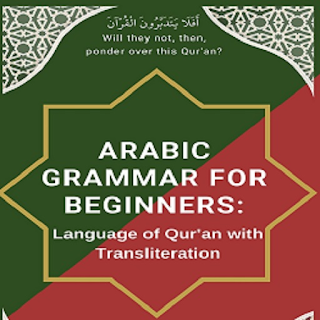4.0/4.1/4.1A/4.1B - Compounds/Incomplete /Descriptive/Demonstrative
Section 4.0 – Compound مُرَكَّبٌ mu-rak-ka-bun Definition
A compound is made up of 2 or more words. Compounds are divided into two categories. Either it is an incomplete compound (a phrase) or a complete compound (a sentence). An incomplete compound is something that does not convey a message completely and leaves a listener unsure about what was said. For example, if I say the Book of philosophy, one may ask the question: what about it? A complete compound conveys a message and the listener understands what is being meant. For example, if I say this is a book of philosophy, this would be a complete sentence.
An incomplete compound is calledالْمُرَكّبُ الْغَيْرُ مُفِيْدُ mu-rak-ka-bul ghai-ri-mu-fee-dinwhich means non-useful compound and a complete compound is called مُرَكَّبُ الْمُفِيْدِ mu-rak-ka-bul mu-fee-di which means useful compound. It is also called المُرَكَّبُ التَّامِّ mu-rak-kabu-tam-mi or a complete compound/ sentence.
An incomplete compound is used as a part of a complete compound or sentence.
Section 4.1 - Incomplete Compounds المُرَكّبُ الْغَيْرُ الْمُفِيْدُ al-mu-rak-ka-bul ghai-rul mu-fee-di
There are four commonly incomplete compounds:
A. Descriptive Compound الْمُرَكَّبُ التَّوصِيْفِيْ (al-mu-rak-kab-ut tausifi)
B. Demonstrative Compound الْمُرَكَّبُ الْاِشَارِيْ (al-mu-rak-kab-ul ishari)
C. Possessive Compound الْمُرَكَّبُ الْإِضَافِيْ (al-mu-rak-kab-ulidaafi)
D. Genitive Compound الْمُرَكَّبُ الجَّارِيْ (al-mu-rak-kab-ul jaari) and Particles حُرُوْفُ الْجَرِّ (huroof-ul-jarri)
Each of these will be described in detail in the following sections.
A. Descriptive Compound الْمُرَكَّبُ التَّوصِيْفِيْ al-mu-rak-ka-but Tau-si-fee
A Descriptive Compound is that in which a quality or a descriptive Noun (an adjective) is associated with another Noun. For example, intelligent man, scholarly woman, black pen, etc. The Noun that is described is called a مَوْصُوْفٌ (mau-soo-fun) and the quality/ description is called an adjective صِفَّةٌ (Sif-fa-tun). Following rules apply:
Rule no. 1: It is required that صِفَّةٌ Sif-fa-tun follow the Mau-soof in all 4 requirements for a Noun. It should have the same wus-at, jins, adad,and flexibility. If a مُوْصُوْفٌ mau-soo-funis a definite Noun, male, single and Nominative, then, صِفَّةٌ sif-fa-tun also has to have the same properties.
Rule no. 2: the described مُوْصُوْفٌ (mau-soo-fun) comes before the adjective صِفَّةٌ (sif-fa-tun) which is the opposite of English language usage where adjective comes first and described مُوْصُوْفٌ (mau-soof-un) after it.
Rule no. 3: An additional rule you should be aware of is that in numbers (adad) part of the properties, if the مُوْصُوْفٌ (mau-soof-un) is a non-intelligent being, then صِفَّةٌ Sif-fa-tun can be used as a singular. In this case مُوْصُوْفٌ (mau-soof-un) could be, for example, a definite Noun/ plural/ female/ Accusative نَصْبٌ (nas-bun) and its صِفَّةٌ (Sif-fa-tun) could be a definite Noun/ single/ female/ accusative. For example, اَبْوَابٌ مَفَاتِيْحٌ ab-waa-bun ma-faa-tee-hun meaning open doors can also be اَبْوَابٌ مَفْتُوْحَةٌ ab-waa-bunmaf-too-ha-tun.
Following are a few examples:
1. A scholarly man رَجُلٌ عَالِمٌ ra-ju-lunaa-li-mun Note that raju-lun is an indefinite Noun, masculine, singular and flexible in the state of Nominative. Therefore, عَالِمٌ (aa-li-mun) is also indefinite, masculine, singular, and Nominative. If we were to say “the scholarly man”, since we are making it a specific person, the proper translation would be اَلرَّجُلُ العَالِمُ ar-rajul-ulaa-li-mu. The word for man was made definite by adding اَلْ (al) which also replaces the tanweento a single dammahand therefore the صِفَّةٌ (sif-fa-tun) has to be a definite and an اَلْ (al) was added to it to make it definite.
2. Two scholarly women would be صَالِحَتَانِ إِمْرَأتَانِ (Im-ra-ata-ni Sa-le-ha-ta-ni). Note that, إِمْرَأتَانِ (meaning two women) is a مُثَنّٰى (mu-than-na) dual for إِمْرَأةٌ (meaning a single woman). صَالِحَتَانِ is a مُثَنّٰى (mu-than-na) dual for صَالِحَةٌ. So, both صِفَّةٌ (Sif-fa-tun) and (Mau-soo-fun) are indefinite, female, مُثَنّٰى (mu-than-na) dual and both are Nominative.
3. Good kids would be translated as الْطَيِّبُوْنَ اَلْاَطْفَالُ al-at-faa-lul tay-yi-boo-na. The (mau-soof) اَلْاَطْفَالُ al-at-faa-lu is plural for طِفْلٌ tif-lun meaning a child and الْطَيِّبُوْنَ is plural for طَيِّبٌ tay-yi-bunmeaning good. So, both (mau-soof) and صِفَّةٌ (Sif-fa-tun) are definite by اَلْ, male, plural, and are in Nominative.
Some examples of Descriptive Compounds with their meaning are given in Table 9 below.
Table 9 - Descriptive Compound Examples
| Phrase/Incomplete Compound | Arabic Version | Transliteration | Properties of صِفَّةٌ Sif-fa-tun and Mau-soof-un | |
| Truthful Muslim (single) | مُسْلِمٌ صَادِقٌ | Mus-li-mun Saa-diq-un | Male, single, common Noun in Nominative رَفْعٌ (raf-un) state | مُذَكَّرٌ، مُفْرَدٌ ، .نَكِرَةٌ ، رَفْعٌ |
| Two Truthful Muslims (mu-than-na) dual | مُسْلِمانِ صَادِقَانِ | Mus-li-maa-ni Sa-di-qaa-ni | Male, dual, common Noun in Nominative رَفْعٌ (raf-un) state | مُذَكَّرٌ، مُثَنَّىٰ ، .نَكِرَةٌ ، رَفْعٌ |
| Truthful Muslims (plural) | مُسْلِمُوْنَ صَادِقُوْنَ | Mus-li-moo-na Saa-di-qoo-na | Male, plural, common Noun in Nominative رَفْعٌ (raf-un) state | مُذَكَّرٌ، جَمْعٌ ، .نَكِرَةٌ ، رَفْعٌ |
| Truthful Muslimahs (single) | مُسْلِمَةٌ صَادِقَةٌ | Mus-li-ma-tun Sa-di-qa-tun | Female, single, common Noun in Nominative رَفْعٌ (raf-un) state | مُوْنَّثٌ، مُفْرَدٌ ، .نَكِرَةٌ ، رَفْعٌ |
| Two Truthful Mus-limahs (dual) | مُسْلِمَتَانِ صَادِقَتَانِ | Mus-li-ma-taa-ni Saa-di-qa-taa-ni | Female, dual, common Noun, Nominative رَفْعٌ (raf-un) state | مُوْنَّثٌ ، مُثَنَّى ، .نَكِرَةٌ ، رَفْعٌ |
| Truthful Muslimahs (plural) | مُسْلِمَاتٌ صَادِقَاتٌ | Mus-li-maa-tun Saa-di-qaa-tun | Female, plural, common Noun, Nominative رَفْعٌ (raf-un) state | مُوْنَّثٌ ، جَمْعٌ ، .نَكِرَةٌ ، رَفْعٌ |
| Old Book | كِتَابٌ قَدِيْمٌ | Ki-taa-bun Qa-dee-mun | Male, single, common Noun, Nominative رَفْعٌ (raf-un) state | مُذَكَّرٌ ، مُفْرَدٌ ، .نَكِرَةٌ ، رَفْعٌ |
| Two old books | كِتَابَانِ قَدِيْمَانِ | Ki-taa-baa-ni Qa-dee-maa-ni | Male, dual, common Noun, Nominative رَفْعٌ (raf-un) state | مُذَكَّرٌ، مُثَنَّى ، .نَكِرَةٌ ، رَفْعٌ |
| Old Books | كُتُبٌ قُدْمَاءٌ or كُتُبٌ قَدِيْمٌ | Ku-tu-bun Qud-maa-un or Kut-tu-bun Qa-dee-mun | Male, plural, common Noun, Nominative رَفْعٌ (raf-un) state | مُذَكَّرٌ ، جَمْعٌ ، .نَكِرَةٌ ، رَفْعٌ |
| Open doors | اَبْوَابٌ مَفْتُوْحٌ Can also be اَبْوَابٌ مَفْتُوْحَةٌ
| Ab-wabun Maf-tu-ha-tun | Male, plural, common Noun, Nominative رَفْعٌ (raf-un) state | مُذَكَّرٌ ، جَمْعٌ ، .نَكِرَةٌ ، رَفْعٌ |
| Numbered days | اَيَّامٌ مَعْدَوْدَاتٌ This can also be
اَيَّامٌ مَعْدَوْدَةٌ | Ayya-mun ma’doo-daa-tun Or Ayya-mun Ma’doo-da-tun | Male, plural, common Noun, Nominative رَفْعٌ (raf-un) state It is also allowed to use a single female for all plurals which are non-intelligent beings | مُذَكَّرٌ ، جَمْعٌ ، .نَكِرَةٌ ، رَفْعٌ |
| Straight path | صِرَاطٌ مُسْتَقِيْمٌ | Si-raa-tum mus-ta-qee-mun | Male, single common Noun, Nominative رَفْعٌ (raf-un) state | مُذَكَّرٌ ، مُفْرَدٌ ، .نَكِرَةٌ ، رَفْعٌ |
| Beautiful watch | اَلسَّاعَاتُ الْجَمِيْلَاَتُ | As-sa-aa-tul jam-ee-laa-tu | Female, plural, proper Noun, Nominative رَفْعٌ (raf-un) state | مُوْنَّثٌ ، جَمْعٌ ، مَعْرِفَةٌ ، رَفْعٌ |
| Two hardworking boys | اَلْوَلَدَانِ مُجْتَهِدَانِ | Al-wala-daa-ni muj-ta-hi-da-ni | Male, plural, proper Noun, Genitive جَرٌّ (jarr-un) state | مُذَكَّرٌ ، جَمْعٌ ، مَعْرِفَةٌ ، جَرٌّ |
| Small book | كِتَابً صَغِيْرً | Kita-bun Sa-ghee-run | Male, single, accusative, Nominative رَفْعٌ (raf-un) state | مُذَكَّرٌ ، مُفْرَدٌ ، .نَكِرَةٌ ، نَصْبٌ |
| Big Mosque | مَسْجِدٌ كَبِيْرٌ | Mas-ji-dun Ka-bee-run | Male, single, common Noun, Genitive جَرٌّ (jarr-un) state | مُذَكَّرٌ ، مُفْرَدٌ ، .نَكِرَةٌ ، جَرٌّ |
B. Demonstrative Compound الْمُرَكَّبُ الْاِشَارِيْ al-mu-rak-ka-bul ishaa-ri
To Understand a Demonstrative Compound, first we need to know the demonstrative pronouns in Arabic. These are words, such as this and that, used to indicate which entities are being referred to and to distinguish those entities from others.
Again, unlike English, in Arabic language, demonstrative pronouns change with three of the four requirements for a Noun. That is Gender, Number, and Flexibility. The flexibility remains unaffected. Also, like most other languages including English, they are used to point to an entity either near or far.
For example, هٰذَا (haa-zaa) is used for a near entity that is male, single, and in Nominative رَفْعٌ (raf-un) state. See Table 10 below.
Table 10 - Demonstrative pronouns
|
| Single مُفْرَدٌ Muf-rad | Dual مُثَنّٰى | Plural جَمْعٌ Jama | |
| Nominative رَفْعٌ raf-un | Accusative/Genitive نَصْبٌ/جَرٌّ Nas-bun/jarr-un | |||
| Near | هٰذَا haa-dha This male | هٰذَانِ haa-dhaa-ni These two males | haa-dhai-ni These two males | Haa-oo-lai These |
| هٰذِہِ Haa-dhi-hi This female | Haa-taa-ni These two females | هَاتَينِ Haa-tai-ni These two females | ||
| Far | Dhaa-li-ka That male | ذَانِكَ Dhaa-ni-ka Those two males | ذَيْنِكَ Dhai-ni-ka Those Two males | اُوْلٰٓئِكَ oo-lai-ka Those |
| تِلْكَ Til-ka That female | تَانِكَ Taa-ni-ka Those two females | تَيْنِكَ Tai-nika Those two females | ||
For a beginner, it may be appropriate to memorize the first and fourth columns of the above table 10 above which contains the most used demonstrative pronouns. The full table is provided for a complete picture, awareness, and for later use.
A demonstrative compound is made by adding a demonstrative pronoun in front of any Noun with the condition that the three properties gender, number, and flexibility match between them. Note the order is the same in Arabic as in English. The demonstrative pronoun comes first and the Noun being pointed next. See examples in Table 11 below.
Examples:
Table 11 – Demonstrative Compound Examples
| Near | Far |
| Nominative رَفْعٌ (raf-un) Males
This man هٰذَا رَجُلٌ These two men هٰذَانِ رَجُلَانِ. These men رِجَالٌ هٰؤُلٓاءِ.
Accusative نَصْبٌ (nas-bun) /Genitive جَرٌّ (jarr-un) Males
This man هٰذَا رَجُلٌ These two men هٰذِيْنِ رَجُلَيْنِ Those men هٰؤُلٓاءِ رِجَالٌ
Nominative رَفْعٌ (raf-un) Females
That woman إِمْرَاةٌ هٰذِہِ Those two women هَاتَانِ إِمْرَاتَانِ Those women اُوْلٰٓئِكَ نِسَاءٌ
Accusative نَصْبٌ (nas-bun) /Genitive جَرٌّ (jarr-un) Females
That woman هٰذِهِ إِمْرَاةٌ Those two women هَاتَانِ إِمْرَاتَانِ Those women هٰوْلَاءِ نِسَاءٌ
| Nominative رَفْعٌ (raf-un) Males
This man is written as ذَالِكَ رَجُلٌ These two men ذَانِكَ رَجُلَانِ. These men رِجَالٌ هٰؤُلٓاءِ.
Accusative نَصْبٌ (nas-bun) /Genitive جَرٌّ (jarr-un) Males
This man تِلْكَ رَجُلٌ These two men ذَيْنِكَ رَجُلَيْنِ Those men هٰؤُلٓاءِ رِجَالٌ
Nominative رَفْعٌ (raf-un) Females
That woman هٰذِهِ إِمْرَاةٌ Those two women تَانِكَ إِمْرَاتَانِ Those women اُوْلٰٓئِكَ نِسَاءٌ
Accusative نَصْبٌ (nas-bun) /Genitive جَرٌّ (jar-un) Females
That woman هٰذِهِ إِمْرَاةٌ Those two women تَيْنِكَ إِمْرَاتَانِ Those women هٰوْلَاءِ نِسَاءٌ
|





Comments